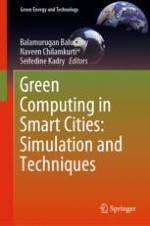Abstract
Green ICT is the Green Information Technology or Green computing and it is required for keeping the Harmless Green Environment even when people are using Electronic computable and storage devices for various purposes tremendously. Finally, the green computing is about reducing the energy usage in communication, networking and, data processing devices and various servers. The communication, networking and data processing devices are the major components which use high energy for its operation. So here comes the time to choose green energy efficient devices for communication, networking and data processing. The application area like video surveillance communication, clustering networks spends lots of energy to do its work. Again, to add up secure communication, it is spending considerably more energy for encryption and decryption processing. The Wireless Sensor Network (WSN) is aided with tremendous technological growth and it is widely used in many applications like Border Monitoring System (BMS), Forest Monitoring System (FMS), Ocean Monitoring System (OMS), Critical Response System (CRS), etc. Generally, in all the surveillance systems the sensor nodes capture the data and send them to the Storage Node (SN) for further processing. The foremost challenges faced by all these WSN applications are formulating Green Communication and Networking (an efficient clustering technique) to handle the group of the sensor nodes and also to ensure secured data transmission. These adverse consequences lead to the challenges which are high energy consumption, more bandwidth utilization, wastage of memory in SNs and unsecured data transmission (challenge to the Green environment). The main objective of this chapter is to provide solutions to the challenges listed above thereby assuring the Green environment suitable (efficient, effective and secured) data transmission, networking and data processing in the WSN applications. This chapter includes choosing a Green energy efficient clustering technique, providing good cryptography algorithm and eliminating redundant data. There are so many clustering techniques adapted in WSN such as Low Energy Adaptive Clustering Hierarchy (LEACH), Hierarchical Clustering Control (HCC), Energy Efficient Unequal Clustering (EEUC), Power Efficient and Adaptive Clustering (PEACH), and Scalable Energy Efficient Clustering Hierarchy Protocol (SEECH) clustering techniques. The applications mainly focused are BMS and FMS to reduce the energy. The impact of the clustering parameters is studied in detail and based on this study the LEACH clustering technique is used to fulfill the needs of a good cluster. The clustering parameter values used in LEACH are: clustering type is dynamic, Cluster Head (CH) count is variable, CH selection is randomized, CH mobility is fixed and finally the CH hop distance is one hop distance. The performance of LEACH is studied. Also, it is compared with EEUC, HCC, and PEACH clustering techniques. To address the challenge of secured data transmission in the WSN the cryptographic algorithms are studied. The Private Key Cryptography algorithms such as the Data Encryption Standard (DES), Advanced Encryption Standard (AES), Rivest Cipher 4 (RC4), Triple DES and Blowfish algorithms are implemented and compared. The cryptographic algorithms are compared with the data size ranging from 20 KB to 100 KB and the experimental results show that the Blowfish algorithm takes comparatively less time for encryption and decryption processes in WSN data transmission and it is very much suitable for green computing environment. The other biggest challenge in WSN is data redundancy as the sensor node captures the video data and sends it continuously to the SN without eliminating the redundant data. This causes more energy consumption and bandwidth utilization in data transmission and may not be advisable for green environment, also more storage space is wasted in SN. The literature review shows that in most of the WSN applications the redundant data are handled only at the SN. But this chapter works a novel algorithm called, Green environment suitable Intelligent Duplicate Check Algorithm (IDCA) is proposed to make the sensor node intelligent by not transmitting the redundant data. So, the sensor node is made intelligent to identify the redundant data in the system before data transmission. To implement this proposed IDCA, the surveillance video data set is taken from different sources. The OpenCV package in python is used to execute this algorithm. Thus, this chapter provides energy efficient and secured data transmission model for WSN applications by using the LEACH clustering technique to form clustered WSN with blowfish cryptographic algorithm for secured data transmission and also making the WSN’s sensor nodes intelligent with a novel IDCA.
